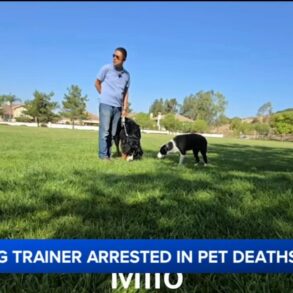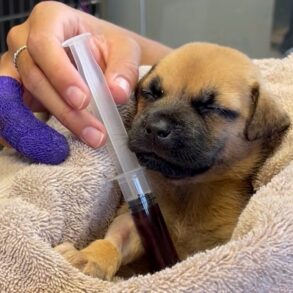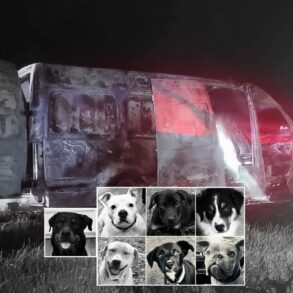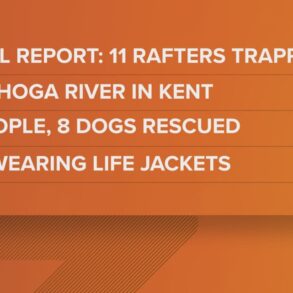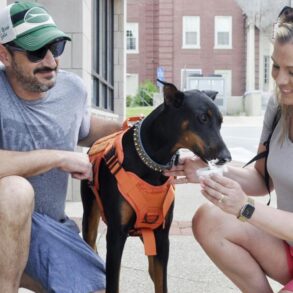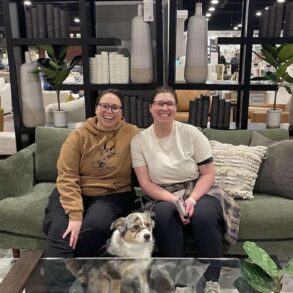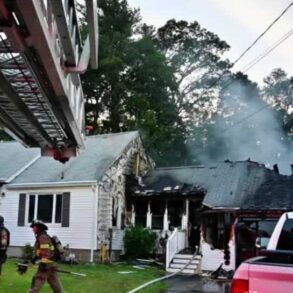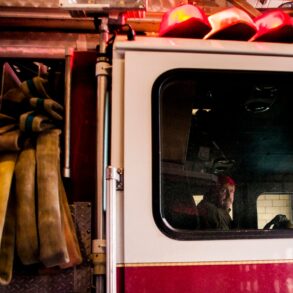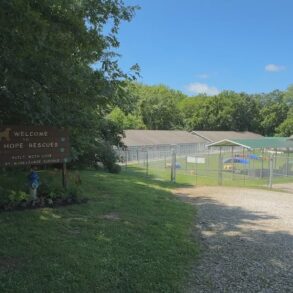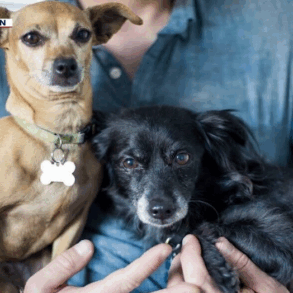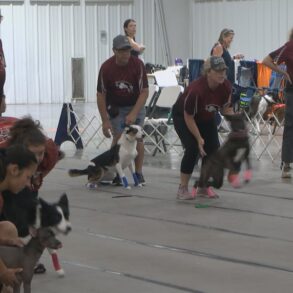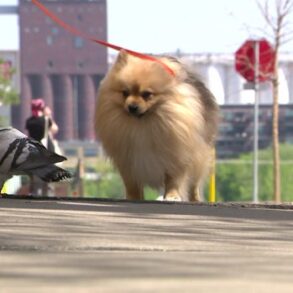
City of Las Vegas Animal Care Center Manager Bea Gallegos handles Matilda at the animal shelter on Sept. 5.
If you live in Las Vegas, you know about the dogs.
You know there are large dog packs running on the streets. Maybe your grandma doesn’t want to walk down by the river because she doesn’t feel safe. Some are feral, while others are pets, and they run all over the place.
Everyone has an opinion about what to do, but things don’t seem to change.
This series will look at animal control issues in Las Vegas, from a solution-oriented point of view, exploring not just the problem, but what we might be able to do about it.
•••
Better accommodations for the city’s homeless cats and dogs – and a nicer workplace for those who care for them – are being planned, thanks to efforts made during the most recent Legislative Session.
During the 2024 session, the city of Las Vegas was awarded $780,000 in capital outlay funds to build a new animal care facility. This new structure will replace the city’s current animal shelter – the City of Las Vegas Animal Care Center – located at 1680 N. Grand Ave. next to City Hall.
City of Las Vegas Animal Care Center Manager Bea Gallegos said she believes the current facility was built in the 1970s.
This is the first time the city has gotten such a large amount of money for its animal shelter, said City Manager Tim Montgomery. He commended the city’s elected officials and Gallegos for helping to secure the funds.
“The mayor (David Romero), our (city) councilors and Beatrice (Gallegos) … they were all participants at the Legislative Session,” Montgomery said during a telephone interview on Tuesday. “The messaging just really worked. … Those efforts all paid off.”
The funds will be used to create a concept design for the new structure, Montgomery said.
“This is really the initial stages of setting up the (new) animal control,” he said. “These monies will be used for the concept design, the architectural design.”
This design phase will include visits to animal care facilities throughout the state, Montgomery said, and several additions to the city’s animal shelter will be explored. Gallegos said keeping the animals happy and healthy is part of the planning, and this includes allowing for cats and kittens to have a larger space where they can play, walk around, climb.
“That’s what cats do,” Gallegos said, adding that it is not good for kittens to remain in small kennels where they cannot do these things.
An area for medical treatment of the animals at the new shelter is also being discussed.
Montgomery said there is a desire for the new shelter to have a quiet space where people can meet animals they may want to take home.
“We want to make sure that there’s a room where the community can come in and spend time in a quiet space, get to know a cat or a dog (and) potentially adopting,” he said. Gallegos also wants a space where shelter workers can do tasks without being surrounded by loud noises all the time, she said.
Blueprints of the new facility will then be created, Montgomery said. Through a bidding process, various contractors will be able to state how much it would cost to actually build the facility. This, in turn, would tell the city how much the new shelter would cost to build.
At that point, the city will know how much to request to start construction.
“That allows us to move forward for additional (money),” Montgomery explained.
Gallegos said the possibility of having one company create the blueprints as well as budget how much it would cost to build has also been discussed.
Montgomery said he is unsure where the new animal shelter would be located, but special consideration will be made to ensure it is not only in a quiet area of town, but also that it remains accessible to both animal control agents and the public.
Gallegos noted that, at its current location, the shelter is near the train tracks. She also fears for people who live in the area.
“I can imagine they hear barking at the oddest hours at night,” Gallegos said. “We are very excited about getting a new location, one that would suit us better.”
Shelter pushes behavioral modification, is recognized for its adoptions
Gallegos said she built the current shelter “from the ground up” after the city took it over in July 2022. The Animal Welfare Coalition had managed the shelter up until that point, Gallegos said, and the city assumed responsibility of the shelter after the AWC did not renew its contract to do so.
When the AWC left the facility on North Grand Avenue they took most of the equipment with them, Gallegos said. There was no food for the animals, she said, nor were there bowls to put food in. There were no hoses to keep the space clean or desks where staff could work.
She has spent the past two years purchasing equipment and rebuilding.
“That’s why everything has been so slow,” Gallegos said. “It’s been a very long, stressful journey.”
However, Gallegos – who had been part of the AWC team for about three years before they cut ties with the shelter – remained. Also, the skills Gallegos learned while working with the AWC have been invaluable to her ability to manage the shelter today, she said.
“I owe a lot of my knowledge from working with the AWC,” Gallegos said. Still, when the city took over the shelter, Gallegos said she was “pretty worried.”
“I knew there weren’t a lot of (local) options for people who knew what to do in a shelter,” she said.
Gallegos said she “thought long and hard,” and admitted she had a difficult decision to make when it came to remaining at the shelter or not.
“At the end of the day, my heart was in it always for the animals,” Gallegos said, adding that she agreed to manage the animal shelter when the city took over.
Gallegos has been able to become a dog behavior specialist during her time at the shelter. This has helped her increase the live release rate of dogs as she helps rehabilitate those with behavioral problems, increasing their chances at being adopted.
Gallegos has created behavior programs for fearful and feral dogs at the shelter. She has also shared her knowledge of dog behavior with the animal shelter’s staff. An annual workshop hosted with the Canine-Human Relationship Institute aims to educate shelter staff on how to rehabilitate dogs that are feral or extremely fearful.
During the workshop, shelter workers are taught how to help dogs become more confident and trust people. Gallegos said workers learn about dogs’ body language to understand what they’re trying to communicate.
“We really focus on meeting (dogs) at their level,” Gallegos said. Aside from rehabilitation, dogs are taught basic manners, like refraining from jumping on people.
Gallegos noted that although many dogs can be helped through rehabilitation and training, some cannot, such as extremely aggressive dogs.
“We will help dogs who are nervous or unsure of other dogs, but we won’t put our time into dogs that are truly aggressive towards other animals or towards people,” she said. “It’s our job to keep our community safe. Behaviors like that can only ever be managed, they can never be completely fixed.”
Gallegos’ efforts have led to a noticeable bump in the shelter’s live release rate, which, she said, has gone from about 92 percent-93 percent to about 97 percent.
The live release rate is the percentage of animals that leave the shelter alive, Gallegos explained.
Last year, the shelter was considered a no-kill shelter and was awarded a plaque from the Best Friends Animal Society, a national organization that is a network partner of the local shelter. Last year’s live release rate was 96.99 percent, Gallegos said. The term no-kill, she said, means that an animal care facility has a live release rate of at least 92 percent.
However, the term “no-kill” is a bit of a misnomer, Gallegos said.
“We always tell people there is no such thing as a no-kill shelter,” Gallegos said. “At some point, every (shelter) has to put an animal to sleep.”
“We get animals that have been hit by cars and (are) suffering,” she continued. “In our case, we get dogs that are way too aggressive to be released.”
The City of Las Vegas Animal Care Center by the numbers
The city of Las Vegas invests about $591,000 a year into the animal shelter, Montgomery said. San Miguel County invests about $50,000 a year in the facility.
Montgomery said the city is often able to accommodate the needs of the shelter.
“Every year, the city goes through the budget process,” he said. “Beatrice (Gallegos) will come forward and she’ll let us know if there’s any special initiatives, if there’s anything specific that we need to do differently.”
Montgomery said that, for example, he was able to increase the FY 2024-25 budget by $40,000 to help with the shelter’s maintenance and repairs.
“I also added uniform costs,” Montgomery said. “The (shelter) staff (can) wear scrubs now.”
The shelter houses, on average, between 55-60 animals, Gallegos said. There are 30 dog kennels and six kennels for cats. There are plans to expand the cat capacity.
It takes about $350 to house a dog with no medical issues or injuries for a month at the shelter. That includes vaccines, spay/neuter, food and cleaning expenses, Gallegos said.
It costs about $300 a month to house a healthy cat.
Ideally, animals stay at the shelter for a month, Gallegos said, but those with behavioral needs may stay from two to six months. There is no time limit for how long an animal can stay at the shelter, she said.
Aside from Gallegos, there are three full-time positions and two part-time positions at the shelter. Although there are two animal control officer positions with the city, one is vacant, Montgomery said.
Montgomery encouraged all those interested in the animal control officer position to apply. One can inquire about the animal control position at the Las Vegas Police Department, Montgomery said. He suggested speaking with Lt. David Lautalo to get more information about the position, including the application process, job requirements, training and certification process.
Montgomery commended the current animal shelter staff, which consists of people who have been at the facility for a long time. He noted that Las Vegas has had to deal with an increase of displaced animals in the aftermath of the Hermits Peak/Calf Canyon Fire.
“We have seen a large increase in displaced animals from the fire,” Montgomery said. “(With) animals out in the community like that, the (animal) population rose rather quickly.”
“The team that we have at the animal shelter has done a phenomenal job trying to balance that effort of getting animals off the street,” Montgomery continued. “I’m so glad they’re going to have this new facility.”
This post was originally published on this site be sure to check out more of their content.



